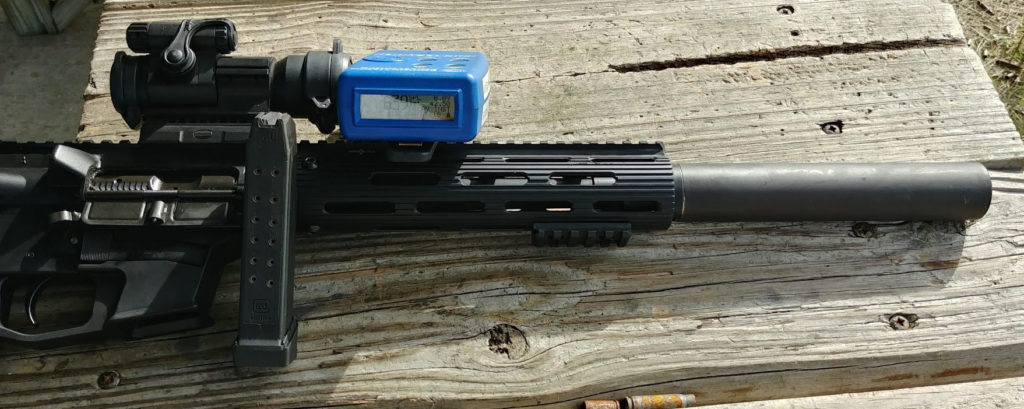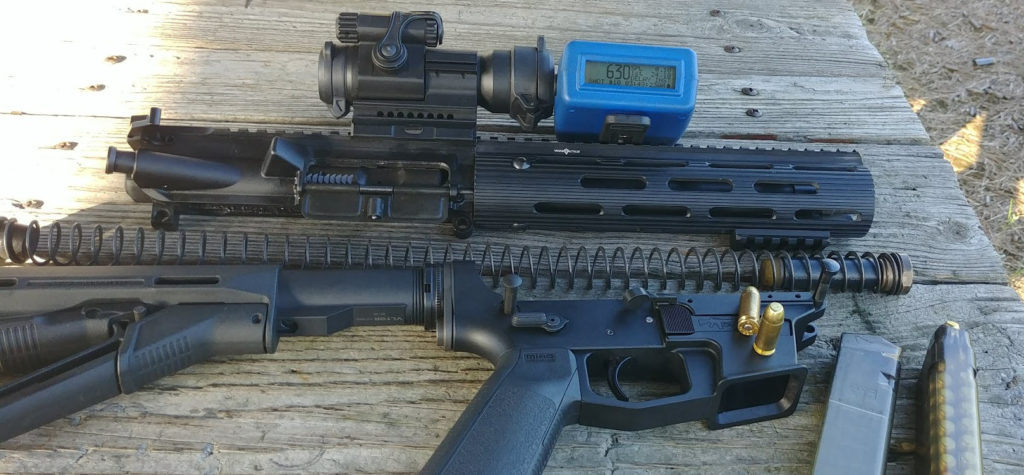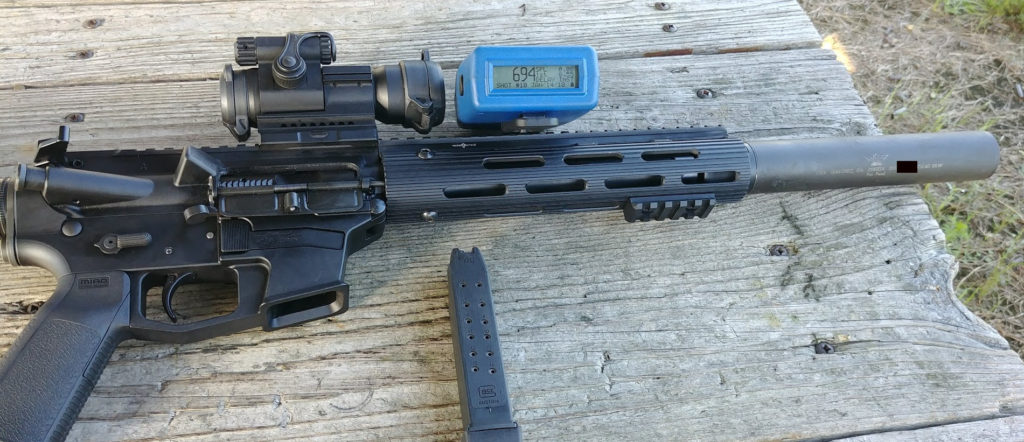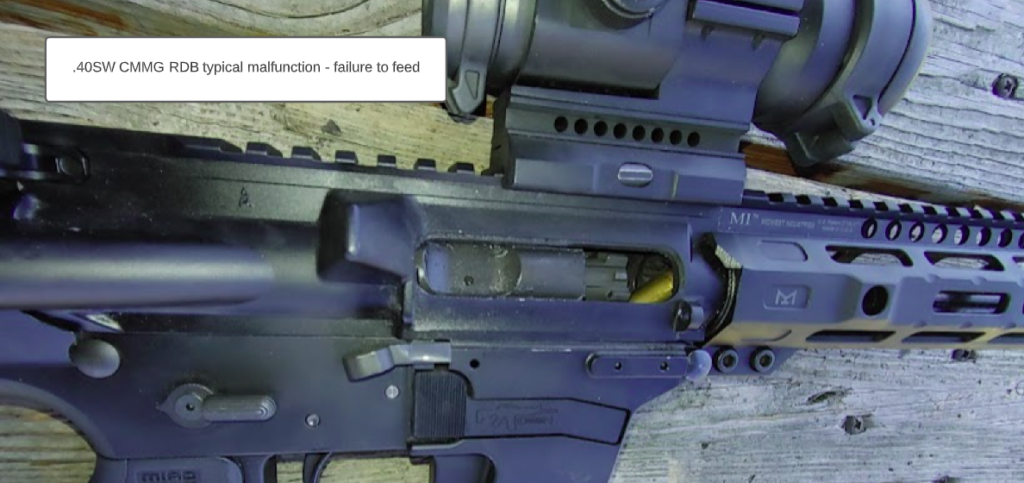I’ve found that I couldn’t get the same level of reliability using my preferred buffer tube, buffer (Kynshot RB5007) and spring (556 Tubb flat spring) setup I use for the 9mm and .45 CMMG RDB builds. What would happen is failure to fully chamber the round.
So, I’m currently running:
Vltor A5 tube
MGI heavy buffer (carbine length)
308 Tubb flat spring
New Frontier Armory spacer since I’m using the carbine length buffer in the A5 which allows the buffer spring to use the extra length but prevents the carrier from going back to far.
I may mess around with A5 buffers later which is why I’m leaving the A5 tube installed at this time.
This yields a nice cyclic rate of 602 RPM. It has been pretty reliable but the ejector springs still fail around 1K rounds like it does in 9mm.
Suppressor is an old SWR GSG40 with custom Curtis Tactical ‘Bixler’ 3 lug mount. Almost 40 RPM increase in cyclic rate at 639 RPM. Reliability suffers some when suppressed, I occasionally get failures to fully chamber the round.
9/5/20
Still having some reliability issues with this configuration . It requires a good amount of force to fully chamber the round while at the same time if there is too much mass for it to overcome, it will have malfunctions on the rearward stroke.
I am currently using a custom tungsten weight (5.1 oz) in the carrier.
Removed the MGI buffer and replaced with a rebuilt Griffin Armament SOB buffer. Same 308 Tubb flat spring, A5 tube and spacer.
Cyclic rate went up about 30 RPM more with this lighter buffer when unsuppressed.
Suppressed, rate is similar to what I see in many of the 9mm RDB configurations with an approximate 60 RPM increase. However, it is much more reliable with these components than anything else I have tested so far. Even at this cyclic rate, I can still pull single round bursts at will.
9/6/20 Configuration above ran several mags flawlessly yesterday then went to SMG match today and it started giving me malfunctions to fully chamber rounds again sometimes. I went back the MGI buffer and unsuppressed and ran 1 stage clean. Later starting to do the same thing again. Did have 1 failure to eject so ejector spring may be starting to go again. Need to measure how strong it is but I’d say I’m not even at 500 rounds yet. I’m going to go back to the spring loaded tungsten weight in the carrier and try that. If that with the GA SOB buffer. I may try replacing one of both the of the GA SOB weights with tungsten as well.

10/10/20 – The .40SW RDB has been very temperamental for me. Using all tungsten weights in the GA SOB didn’t help. Ran about 500 rounds today with various configurations and have come to the following conclusions.
- The custom 5.1 oz tungsten carrier weight has greatly reduced the issue of not fully chambering rounds. I didn’t want to have to resort to adding mass to the carrier but it seems that this has worked the best for curing that issue.
- Other common malfunction is failure to feed where the round feeds at a steep angle and jams. I am thinking this is being caused by too much BCG velocity. I’ve gone away from the 308 Tubb flat spring to the 556 Tubb flat spring and that seemed to greatly reduce that malfunction from occurring. Note that I was using the 308 spring for additional force to chamber the round but the 5.1 tungsten weight in the carrier fixes that.
- As seen in the cyclic rate tests above, the .40SW can adds around 40-60 RPM increase in the cyclic rate…which increases the BCG velocity and causes the FTF malfunction. Switching to a .45 suppressor which has a larger bore aperature and less back pressure has greatly helped. I ran several mags using the same configuration I use for the .45 CMMG and many of my 556 builds has worked out well…556 Tubb flat spring, A5 tube, RB5007.
- The same buffer/spring configuration was consistently having malfunctions on the last round when un-suppressed. Swapping the RB5007 for the Vltor A5H4 seems to have corrected this issue. However that same buffer doesn’t work as reliably as the RB5007 when suppressed. So I need to use different buffers when suppressed and un-suppressed.
Pictured below is the suppressed configuration that currently appears to be reliable. Suppressor is re-core by Curtis Tactical. I plan on writing some more about this suppressor. It has excellent serviceability and performance.
Pictured below is the un-suppressed configuration that currently appears to be reliable.

1/30/2022
I haven’t updated in a while but sometime in 2021 the configuration above has not been 100% either. With the primer shortage, I just stopped messing with the .40SW RDB but still had a good bit of 40SW loaded up. I don’t like having configurations laying around that don’t run so I decided to do two things:
- Get a 10mm CMMG RDB bolt to run in the .40SW suppressed instead of adding mass. Similar to what I’m doing for the 9mm which is using the .40SW bolt instead of the 9mm to control the delay mechanically instead of throwing mass at the problem.
- Rudy @ Macon Armory did a great job on my .45ACP CMMG RDB barrel so since my malfunctions have all been failures to feed in the .40SW, I decided to send my .40SW barrel to him to do his feed code magic.
Pictures below comparing the 10mm to .40SW bolt geometry.

You can clearly tell in the picture below that the 10mm bolt lug angles are not as ‘sharp’ as the .40SW.

I’m guessing 67 indicates the angle off the bore’s axis.
Likewise, I’m guessing that the .40SW is 60 degree’s off the bore’s axis.

Picture below showing the throating by Rudy at Macon Armory.

All testing below was done with the .45 ACP Curtis Tactical re-core pictured above.
Using the same 556 Tubb flat spring, A5 and RB5007, with the 5.1 oz carrier weight and 10mm bolt, it fails to kick the brass out which is what I would expect with the 10mm lugs delaying the action more. So now I can try dumping the 5.1 oz tungsten carrier weight to reduce the reciprocating mass.
Removing the 5.1 oz weight results in kicking the brass out but doesn’t go back far enough for the LRBHO to engage.
I also tried loading one round in the chamber and then inserting a fully loaded 30 round for more resistance on the bottom of the BCG and it cycled fine.
I then switched to the lighter RB5005 (4.7 oz and same 5lbs to compress) and also added a spacer to make sure the key wouldn’t slam into the lower and it was the same thing – not going back far enough for the LRBHO to engage.
Then switched again the RB5000L (4.1 oz and a little over 3lbs to compress) and still no LRBHO.
Update 2-6-2022
Will try running it with the RB5007 even though I don’t get LRBHO. I’d be willing to settle for that if it is reliable since it is very smooth with low reciprocating mass now that the 10mm bolt is delaying the action. – tested this in full auto and was getting failures to feed again.
I then tried swapping the Tubb 556 spring for a standard AR buffer spring and the same thing – failures to feed.
Then swapped changed to the 300BLK Tubb flat spring (which I use for the 9mm CMMG RDB in full auto which results in about 30 RPM slower cyclic rate in full auto). This worked amazingly well. No failures to feed and locked the bolt back. Even more surprising is that this also worked without a suppressor mounted. With the suppressor mounted it also worked well but my shot timer wasn’t able to pick up any of the gunshots with the suppressor mounted. I need to bring it out again to see if I can get my shot timers to pick up the suppressed shots.
I fired about 300 rounds (mostly suppressed) with no failures to feed and LRBHO engaged everytime. I plan on maybe using this at the next SMG match and see if it takes a dump on me then.


The rail was touching the suppressor so I milled off a slight amount off the end.

Update 4/3/2022
I ran the .40SW at the SMG match 100% suppressed. 4 bays and typically used (3) 30 round mags per bay. I know one bay I used 4 mags. So call it 400 rounds and I had zero malfunctions. However on the last bay the timer wasn’t working and I had to re-shoot that bay. When I shot it the second time, it had two malfunctions. Both were towards the end of that stage and both were failures to fully chamber the round. The gun was pretty dirty at this point.
I’m pretty happy with it for now and will leave it in this configuration, keeping an eye on the reliability and knowing that it needs to be clean.
Update 5/1/2022
I ran the .40SW at the SMG match 100% suppressed again. I would estimate another 400 rounds of full auto. It ran the entire match with zero malfunctions. I was curious how the ejector spring strength is doing at this time so when I pushed on it, I could tell it was pretty weak and surprised it didn’t give me any failures to eject during the match. I typically say you should change them when they are at 5 lbs or less and this one is definitely due for changing. However, I think I’m going to see when it fails unless I’m going to do another match with it.

